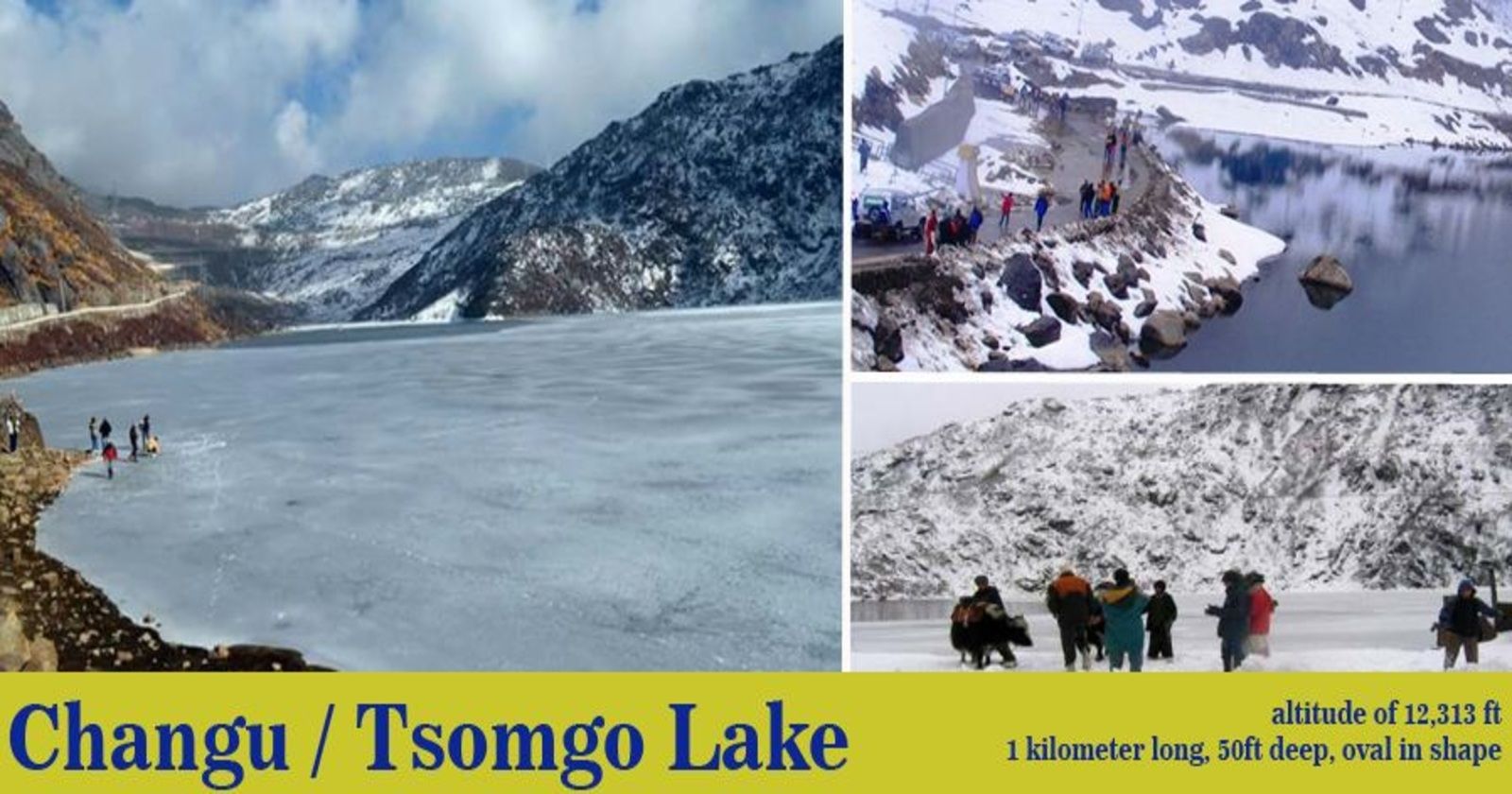Changu Lake, also known as Tsomgo Lake, is a captivating glacial lake nestled in the East Sikkim district of the Indian state of Sikkim. Renowned for its serene beauty, spiritual significance, and ecological richness, this natural wonder attracts tourists, pilgrims, and nature enthusiasts alike. Its geographical location, unique etymology, scenic charm, wildlife, and religious importance make Changu Lake an essential part of Sikkim’s cultural and environmental heritage.
Location of Changu Lake
Changu Lake is located approximately 40 kilometers east of Gangtok, the capital city of Sikkim, along the national highway leading to Nathu La pass on the Indo-China border. Situated at an altitude of about 3,753 meters (12,313 feet) above sea level, the lake lies in a mountainous rift between two peaks, amidst the lap of the Eastern Himalayan ranges. Its proximity to Gangtok makes it easily accessible for day trips, yet its remote alpine environment preserves its tranquil ambiance and pristine condition.
Etymology and Significance of the Name
The name “Changu Lake” is derived from local terminology rooted in the Bhutia language, spoken by the indigenous communities. The term “Tsomgo,” often used interchangeably with Changu, is a combination of "tso," meaning lake, and "mgo," meaning head. Therefore, Tsomgo literally translates to “the head of the lake” or “source of water.” This name is not merely linguistic but also descriptive; the lake serves as the origin of the Lungtse Chu River, an important tributary that nourishes downstream valleys. The lake thus holds a vital place in the region’s hydrology and ecology.
Scenic Appeal and Natural Splendor
Changu Lake’s geographical setting contributes significantly to its mesmerizing scenic appeal. The lake occupies a rift valley formed by tectonic activity and glacial movements, flanked by towering snow-capped peaks on either side. The crystal-clear water of the lake reflects the surrounding mountains and the deep blue sky, creating a kaleidoscope of colors on its tranquil surface. This reflective quality is especially remarkable during clear days, where the lake mirrors the lush alpine meadows and vibrant sky, offering visitors a picture-perfect view.
The lake’s character changes with the seasons. As a glacial lake, Changu remains completely frozen during the harsh winter months, typically from December through March, when temperatures plunge well below freezing. When the snow thaws in late spring, by around May, the lake swells with meltwater from surrounding glaciers, rejuvenating its life-giving essence. This period also witnesses an extraordinary transformation in the surrounding flora. The slopes bloom with profuse varieties of rhododendrons, rare primula species, blue and yellow poppies, and other alpine flowers that paint the landscape in vivid hues. The springtime blossom creates a stunning contrast against the cool blue waters of the lake, enhancing its vibrancy and allure.
Wildlife and Avian Diversity
Changu Lake and its environs support an array of wildlife, both terrestrial and avian. Among the notable creatures inhabiting the region is the elusive Red Panda, a rare and endangered mammal indigenous to the Eastern Himalayas. The surrounding forested areas provide sanctuary to this shy creature, though sightings remain infrequent due to its covert nature.
Avian life is particularly rich around the lake. Brahminy Ducks (also called Bar-headed Geese) frequent the waters, their distinctive plumage brightening the lake’s surface. Birds of various species use the lake as a resting and breeding ground, adding to the ecological importance of the area. The presence of such biodiversity underscores the lake’s role as a fragile alpine ecosystem deserving of preservation.
Religious Significance and Cultural Legends
Apart from its natural beauty, Changu Lake occupies a sacred place in the spiritual and cultural traditions of the Sikkimese people. The lake is woven into local myths and legends, considered a holy site by native communities and Buddhists alike. One fascinating belief is that the lake’s water appears in different colors during various seasons, which Buddhist monks and lamas interpreted as omens or signs to foresee future events. This interplay of natural phenomena and spiritual interpretation highlights the valley’s mystical aura.
At the lakeside stands an ancient temple dedicated to Lord Shiva, a principal deity in Hinduism. Devotees regularly visit the temple to offer prayers and seek blessings, especially during auspicious occasions. The temple’s presence further entwines the lake with religious reverence, blending Hindu and Buddhist cultural elements unique to the region.
Moreover, the lake serves as a congregation point for the Jhakris—traditional faith healers of Sikkim—especially during Guru Purnima, a festival that coincides with Raksha Bandhan. The Jhakris gather to perform sacred rites and rituals, drawing spiritual strength from the lake’s purported healing waters. This ritual underscores the deep connection between local healing practices and the lake’s revered status.
Best Time to Visit Changu Lake
The accessibility and allure of Changu Lake fluctuate with the seasons. Winter months render the lake frozen and covered in snow, which although beautiful, makes it less accessible and suitable for high-altitude travel only with proper gear and preparation. The best time to visit is during late spring and early summer—from April to June—when the lake thaws, flowers bloom profusely, and weather conditions are favorable.
Summer months bring pleasant temperatures and clear skies, offering optimal visibility and comfortable trekking conditions. In the monsoon season, however, landslides and roadblocks can pose challenges, and the lake’s beauty is somewhat obscured by clouds and rain. Autumn, similarly, offers a serene experience, with the onset of crisp weather and clear atmospheres.
Conclusion
Changu Lake, also known as Tsomgo Lake, is a captivating glacial lake in East Sikkim, Sikkim. Its pristine waters, vibrant seasonal blooms, diverse wildlife, and deep cultural and religious significance make it an integral part of Sikkim’s heritage. For visitors, scholars, and devotees, Changu Lake offers a memorable experience that celebrates the confluence of environmental grandeur and spiritual heritage, preserving its place as one of Sikkim’s most treasured landmarks.
